
Were a list compiled of my manifold sins and wickedness, near the top of that very long list would be my affection for gadgets that I imagined I needed and therefore purchased. Usually it turned out I didn’t actually need them at all. Sometimes they did end up being useful, though none of them will be mentioned here.
I was a child at just the right time to get fascinated by all the amazing devices of the future, introduced to us by scientific programs such as “The Man from U.N.C.L.E.” and the various James Bond presentations. Such an addiction, unless cut short by becoming extremely bored with life, is terminal.
I was instantly hooked on cool devices that didn’t actually exist. By this I mean tiny wireless communication devices and, of course, tiny portable computers. I began with almost anything that generally resembled either of the above.
Unless I was smart enough to throw it away, there is at the bottom of a box (packed at least three houses ago) a small device made by Sharp or Casio. It was a sort of PDA — personal digital assistant — from the 1980s. On the right side (a bad choice if you’re left-handed) was a kind of touch pad that you could use to write letters on the screen with a fingertip or stylus. The letters would then appear on the left side to show that your writing was being recorded correctly.
There was a fatal problem. For your finger movements to register, they needed to follow a particular path for each letter. This is not an issue in the gadget’s country of origin, Japan, because there the order in which the strokes in hiragana, katakana, or kanji are written is prescribed. It’s not enough to end up with the right character — it must be placed on the paper (or touch screen) following an exact stroke order. As a result, the gizmo — suited for Japanese use — wasn’t a hit here. The show that had shaped us on these shores was “The Man from U.N.C.L.E.,” not “The Man from O.J.I.S.A.N.” It seemed cool, but it wasn’t.
After fiddling with a variety of little hand-held computers on which you could write small, useless programs after consulting manuals the size of Montgomery Ward catalogs, I realized that what I really wanted was a hand-held electronic typewriter. A thing you could write on and maybe even use to send messages. Remember, in the 1980s, this was all new and surprising.
The first dinky computer that one could imagine was good for something was the Atari Portfolio. Slightly bigger than a home video cassette — VHS, not Beta — it opened like a miniature laptop to reveal a keyboard and a small screen. Next to the screen, behind a grille the size of a quarter, was a speaker. Its only speaking was making clicks to confirm that a key had been pressed on the terrible little keyboard.
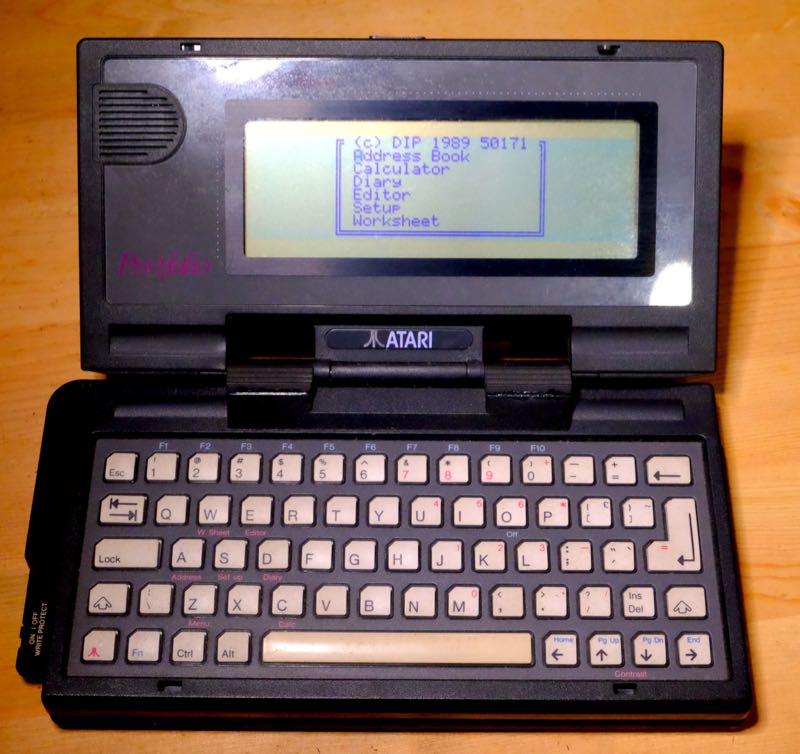
It had a weak computer chip and as close to no memory as could still produce a working device. It was covered with slots and long rows of connector pins, none compatible with anything you had ever seen or ever would. Built in were a small text editor, a small spreadsheet program, and a couple of other programs. It ran for up to three weeks on three AA batteries. It had an adapter half the size of the computer itself that connected to the parallel — printer — port on another computer to transfer files. I still have a 2,500-word piece I wrote on the Amtrak train between New York and Washington the day the Portfolio arrived in June 1989.
It had a slot for additional storage of up to 128 kilobytes of data, or about 1/12 the data that a standard 3.5-inch floppy disk would hold. This expansion card would set you back more than a dollar per kilobyte.
But it was cool, and I got one of the very first batch released by Atari. (It wasn’t an actual Atari product but a re-badged British thing. When it came to strange and largely useless computers, no one outdid the British in the 1980s, with their military-looking Amstrad laptop, their odd Sinclair computers, and now the Distributed Information Processing company’s gadget that Atari would sell as the Portfolio. It ran the unfortunately but appropriately named DIP DOS.
I still have mine. If you like movie trivia, you’ll be delighted to know that it was an Atari Portfolio that teenage John Connor used to hack into a bank — from an ATM — in “Terminator 2.” I never got the “Hack Bank — Steal Money” application to work, though I confess I never tried.
You’d think, and you would be right, that the Portfolio would have proved that such a device, something with a keyboard that small among other things, wasn’t worth the trouble or the price ($400). But I am not one to give up on my dreams, so when Toshiba produced its Libretto series a half decade later, yes, I got one. It was expensive and useless and, in its first generation did not do what was promised — run OS/2. So I returned it. A few years later I was able to get a good deal on a later, more powerful (for the time) model, the 100CT, which came with Windows 98 installed. I played with it a little, thinking I would later install a useful operating system. But it was still pretty awful.
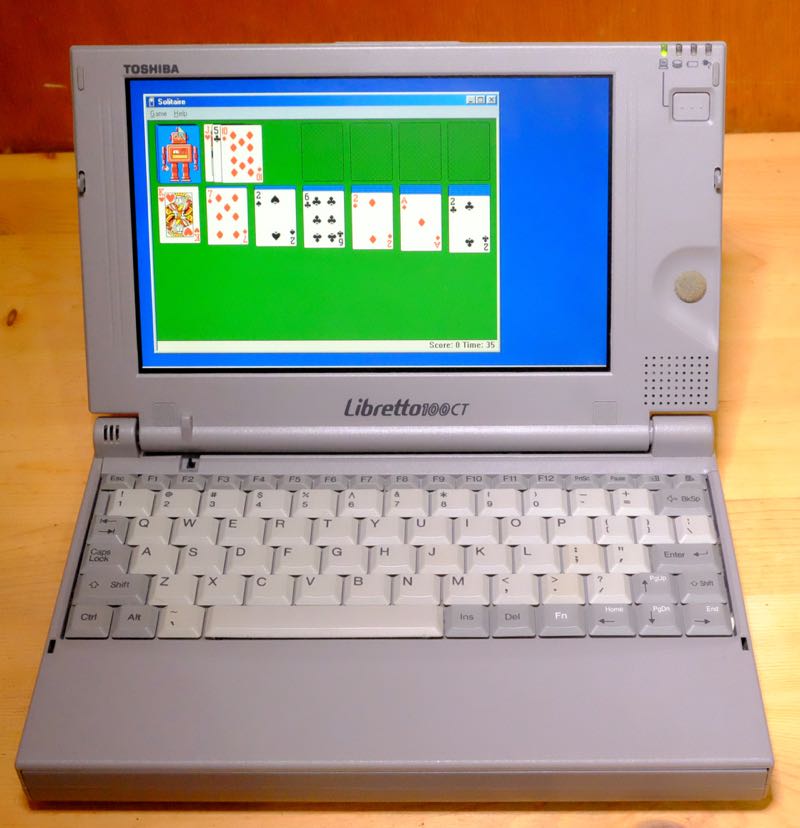
The keyboard had no feel at all, and the keys were tiny. It did have 32 megabytes of memory — megabytes, not gigabytes — and a mechanical hard drive. There was a pointing device built on the same principle as the Trackpoint pointing nub found on IBM Thinkpads. But it was located next to the screen, with the mouse buttons on the back of the screen. I’d get it out, and still do, to play with from time to time.
It had a double PCMCIA slot into which I could insert a combination modem and network card, so I could go online with it. To connect otherwise, including very early USB, I needed to put it into a docking station that had every possible connection common to computers of the day (none regularly found now). The battery didn’t power the thing for long, so carrying a couple of spares was essential. The floppy drive, still necessary at the time, was also connected by PCMCIA. By the time you had gathered the stuff you needed to go on the road with it, you had a pile of stuff that together was as bulky as carrying a regular laptop computer.
(I was beginning to doubt “The Man from U.N.C.L.E.” — for instance, the characters on the show all wore the tight suits fashionable at the time, yet between scenes their amazing pistols grew rifle barrels, shoulder stocks, telescopic sights, and extended magazines. Where they carried all this hardware was never explained. The show was apparently not a documentary series.)
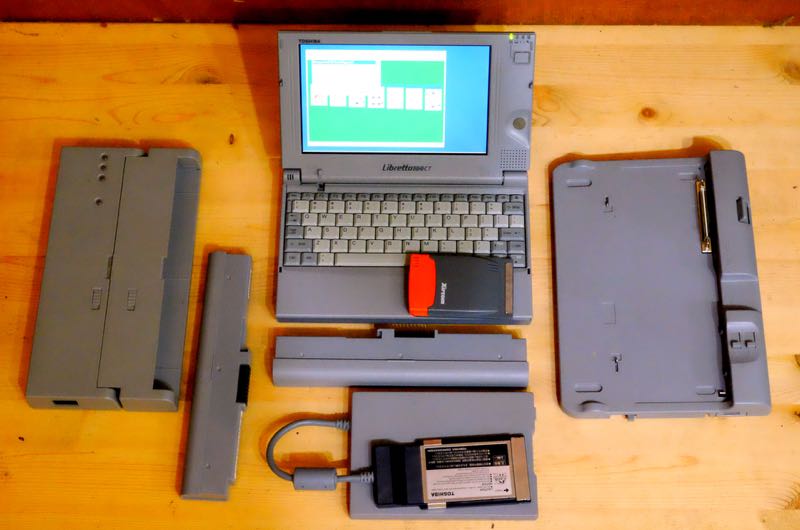
A sensible man would by now have learned his lesson, but when it came to tiny computers I am not often accused of possessing good sense. In 2017 I heard about the Planet Computers Gemini device, a project sponsored through the Indiegogo crowdfunding website, I ponied up the money. After a few months, I had my Gemini.
I mentioned the strangeness of computing devices born in England. The Gemini was born in England, as were its ancestors, the British Psion PDAs. But this thing promised 4 gigabytes of memory, lots of storage that could be expanded via a micro-SD card, a high-resolution color screen, wireless internet, the ability to run Linux, and so on. Also, it was a cellular telephone.
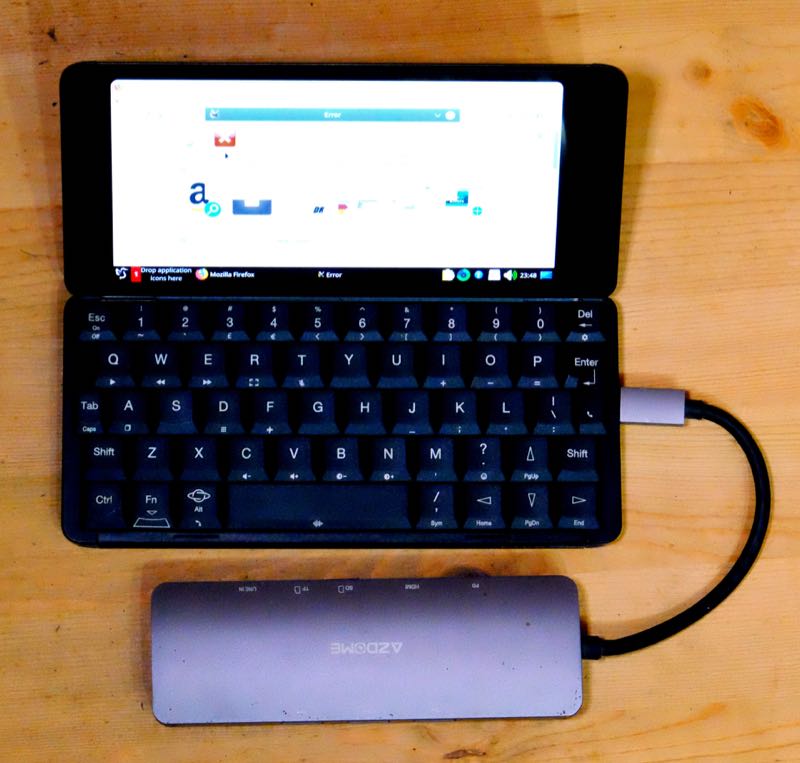
What it didn’t have was a pointing device. You had to use your fingertip. This is problematic when trying to navigate a high-res Linux desktop on a 6-inch screen. It could be done, but it made me so tense that after a few hours my shoulders hurt as if I’d lugged around a huge portable from the old days. I never got the phone to work, but I didn’t spend much time trying: you couldn’t see, for instance, who was calling, and Linux telephony never became what we have hoped for lo, these many years.
The keyboard, though, was great for its size, and I’ve even written columns on it. It runs any Linux application, including the big, complicated ones. I got a little pocket-sized — really — USB docking station, which offered several flavors of USB, slots for both big and little SD cards, connectors for keyboard, mouse, and HDMI for video and sound, even a network socket. I hooked up the docking station to a monitor, keyboard, etc., at the newspaper office. With one connection — docking station to Gemini, I had a fully functioning desktop machine capable of running LibreOffice for writing and the GIMP for photo editing. It was cool. Still is, though the company said batteries were replaceable, which they are — but there are no replacements available. Mine still runs on the original, though charging it a week ago was a worrisome process.
Nor was I done yet.
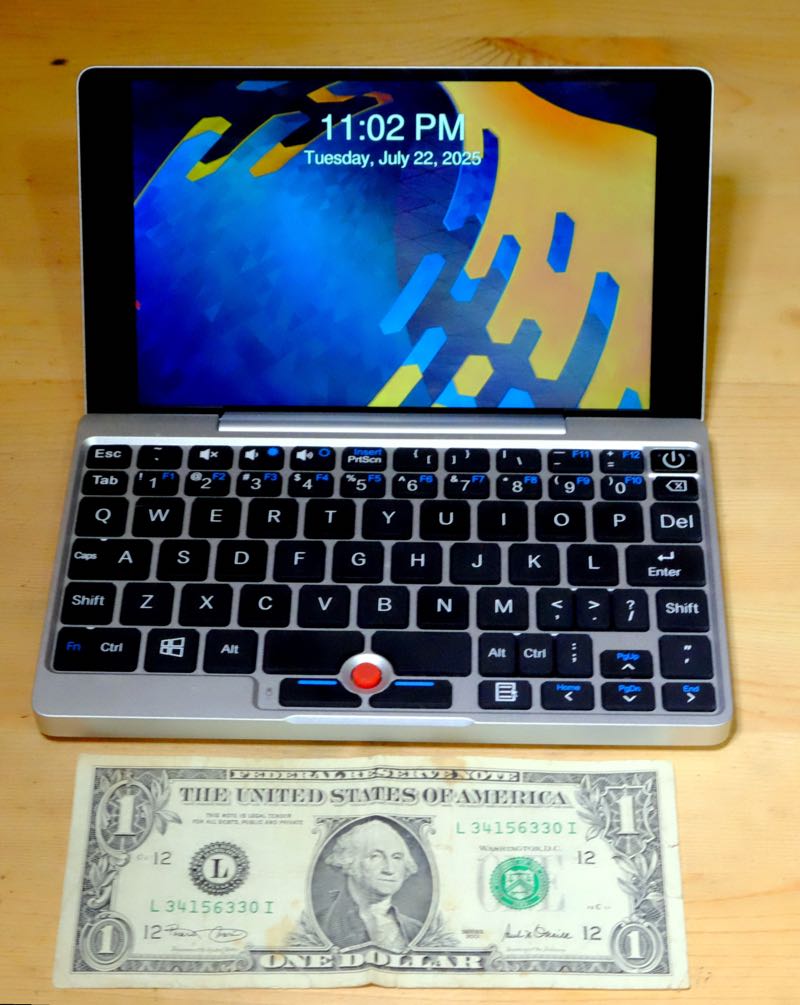
A Chinese company, GPD (for Game Pad Digital) had brought out a thing called the GPD Pocket. It had an actual Intel processor, a keyboard with a Trackpoint-style pointing device, and other features. It was bigger than the Gemini but smaller than the Portfolio or Libretto. It used the Gemini docking station perfectly. And it looked like a MacBook that somebody had forgotten and put in a dryer, causing it to shrink to a size that would fit in a jacket pocket. When they went on sale, I got one. It had twice the memory — 8 gigs — of the Gemini, but no built-in telephone. Replacement batteries for it can be found, though they’re fairly expensive. The screen is a full 1920 x 1080. In addition to the pointing nubbins it has a touchscreen. I hate touchscreens, so my screen remains untouched. The nubbins was placed such that the spacebar is in two pieces, which is annoying in that it’s right above the somewhat smaller mouse buttons.
Looking at them and looking back, I can’t be disappointed in any of them. They all did and still do what they promised (except for the availability of replacement batteries for the Gemini; I haven’t been able to confirm if the company is still in business, though their website appears to be maintained). But I don’t carry one around with me, as I do a camera. And truth be known, for most purposes a tablet or cellular telephone does as well or better. So their use is mostly for amusement, as when for example I get bored and drag one out and write a column on it just because I can.
But they all still awaken the 10-year-old boy who desperately wanted such a device, back when most televisions were black-and-white.

Dennis E. Powell is crackpot-at-large at Open for Business. Powell was a reporter in New York and elsewhere before moving to Ohio, where he has (mostly) recovered. You can reach him at dep@drippingwithirony.com.
You need to be logged in if you wish to comment on this article. Sign in or sign up here.
Start the Conversation